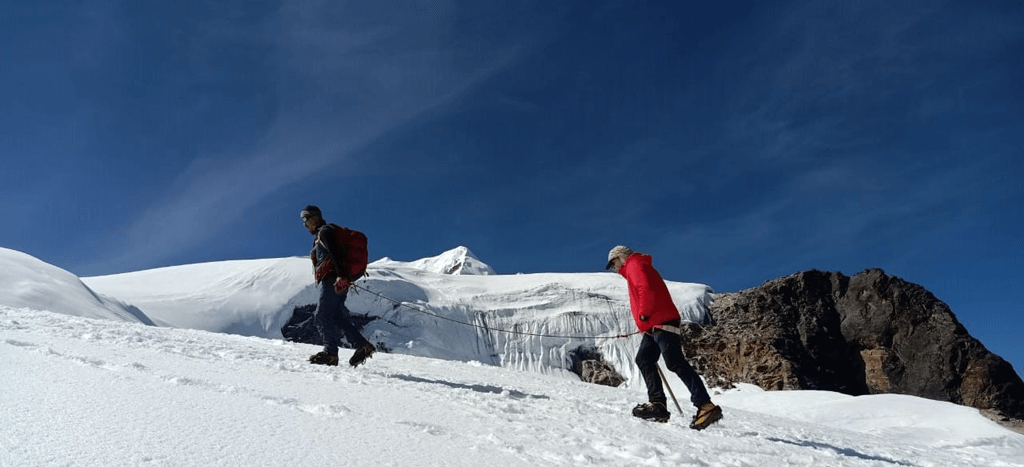17th June, 2025

Apr 08, 2024
Mera Peak Climbing in August
- Mera Peak Climbing Permit and Cost in August
- Why Sherpa Expedition Has Everyday Availability for Mera Peak Climbing
- Preparation and Safety About Mera Peak
- Altitude Sickness and Acclimatization
- Highlights of Mera Peak Climbing In August
- Does Guide Give Us Training at Mera Khare
- Can I Hire Climbing Equipment at Khare
- Can I See Mount Everest From The Mera Peak Top
- Hiring a Down Jacket and Sleeping bag with Sherpa Expedition without any cost
- Why Should You Climb Mera Peak in August
- Mera Peak Weather, Climate, and Temperature in August
- Advantages to Climb Mera Peak in August
- What Should I Pack for Mera Peak Climbing in August
- Why Is Mera Peak Cost Low In August
- What Kind Of Training Do I Need to Do in Advance for Climbing Mera Peak
- Tips For Summiting Mera Peak
- Conclusion
- Mera Peak Climbing Packages
Climbing Mera Peak in August offers a captivating blend of adventure and natural beauty in the heart of the Nepalese Himalayas. As one of Nepal's highest trekking peaks standing at 6,476 meters (21,247 feet), Mera Peak attracts climbers from around the world seeking a challenging yet rewarding experience.
August marks the tail end of the monsoon season in Nepal, bringing lush greenery to the valleys and occasional rain showers that add a dramatic touch to the landscape. The ascent to Mera Peak typically begins with a scenic flight from Kathmandu to Lukla, followed by a trek through dense forests and quaint Sherpa villages. The trail gradually ascends, allowing climbers to acclimatize while enjoying panoramic views of snow-capped peaks and verdant hillsides.
Base camp is established around 5,300 meters (17,388 feet), providing a strategic resting point before the final push to the summit. Climbers prepare here, surrounded by towering peaks like Everest, Makalu, and Cho Oyu visible on clear days. The route to the summit involves traversing glaciers and ascending steep slopes, requiring basic mountaineering skills and the use of equipment such as crampons and ice axes.

Everest Three Pass With Island Peak Climbing
The Everest Three Passes with Island Peak Climbing is a challenging and thrilling trekking and climbing adventure in the Everest region of Nepal. It involves crossing three high mountain passes - Kong...
August's weather on Mera Peak can vary from clear, crisp mornings to cloudy afternoons with occasional showers, highlighting the dynamic nature of mountain weather during the transitional period between monsoon and autumn. Despite potential challenges posed by weather, the quieter trails and greener landscapes make August an appealing time for those seeking a more tranquil Himalayan experience.
Descending back to Lukla concludes the journey, filled with memories of the alpine vistas and personal achievements atop Mera Peak. Climbing Mera Peak in August is not just a physical endeavor but a journey immersed in the natural grandeur and cultural richness of Nepal's mountainous terrain, leaving climbers with a profound appreciation for the majesty of the Himalayas.
Mera Peak Climbing Permit and Cost in August
Climbing Mera Peak in August requires obtaining permits from the Nepal Mountaineering Association (NMA) and a Sagarmatha National Park entry permit. The cost of permits during this month typically reflects the end of the peak trekking season, resulting in moderate fees compared to the busier months of spring and autumn.
The NMA permit fees vary based on the size of the climbing group and the specific peak being climbed. As of recent information, the permit for Mera Peak in August is generally lower due to reduced demand from climbers post-monsoon. Additionally, climbers need to acquire a Sagarmatha National Park entry permit, which contributes to conservation efforts and park maintenance.
Other costs include expenses for guides, porters, accommodation along the trekking route, meals, and transportation from Kathmandu to Lukla, the starting point for the trek. It's advisable to budget for unexpected expenses and to choose a reputable trekking agency that offers transparent pricing and comprehensive support throughout the expedition.

ISLAND PEAK CLIMBING
This is a fantastic climbing expedition that takes you to the summit of "Island Peak (6,189m) situated between Amadablam and Lhotse mountains. This exciting adventure is jam-packed full of features an...
Why Sherpa Expedition Has Everyday Availability for Mera Peak Climbing
Sherpa Expedition maintains everyday availability for Mera Peak climbing due to their extensive network of experienced guides and robust logistical support. Here are key reasons why they can accommodate climbers on a daily basis:
- Large Team of Guides: Sherpa Expedition employs a sizable team of trained Sherpa guides who are intimately familiar with the Mera Peak region. This allows them to organize and lead expeditions flexibly, adjusting to varying client schedules and preferences.
- Logistical Efficiency: The company has established efficient logistics with local suppliers, ensuring reliable access to permits, accommodations, and transport. This logistical strength enables them to schedule expeditions daily, providing flexibility for climbers.
- Customizable Itineraries: Sherpa Expedition offers customizable itineraries, allowing climbers to choose their preferred dates and durations for the Mera Peak expedition. This flexibility caters to individual or group needs without compromising on safety or quality.
- Safety Standards: Despite everyday availability, Sherpa Expedition prioritizes safety. They monitor weather conditions closely, provide thorough briefings on trekking protocols, and maintain emergency communication systems throughout the journey.
Sherpa Expedition's commitment to accessibility and safety makes them a trusted choice for climbers seeking a well-organized and secure expedition experience on Mera Peak.

MERA PEAK CLIMBING
This is an excellent opportunity to climb Nepal’s highest peak without having to obtain a permit (6,476m/21,190ft). From the summit, you will have stunning views of several 8000m plus peaks, such as E...
Preparation and Safety About Mera Peak
Preparation and safety are paramount for Mera Peak climbing, especially in August when weather conditions can vary. Sherpa Expedition emphasizes thorough preparation and safety measures to ensure a successful and secure expedition:
- Physical Conditioning: Climbers should undergo rigorous physical training beforehand to build endurance and strength. Cardiovascular exercises, strength training, and hiking with a weighted pack are recommended.
- Gear and Equipment: Sherpa Expedition provides a detailed gear list and ensures climbers are equipped with appropriate clothing, footwear, and gear for diverse weather conditions. This includes waterproof layers, insulated jackets, trekking poles, and high-altitude sleeping bags.
- Altitude Acclimatization: The itinerary includes gradual ascents with rest days to aid acclimatization. Sherpa Expedition guides monitor climbers for symptoms of altitude sickness and adjust the pace accordingly.
- Emergency Protocols: Sherpa Expedition implements comprehensive emergency protocols, including evacuation plans and access to medical assistance. Guides are trained in wilderness first aid and carry essential medical supplies.
By prioritizing preparation and safety, Sherpa Expedition enhances the overall experience and ensures the well-being of climbers throughout the Mera Peak expedition.

LOBUCHE PEAK CLIMBING
This is a real mountain climbing adventure that will leave you in awe of the beauty of the Himalayan Mountains. The Lobuche Peak Climbing expedition in the Khumbu region of Nepal has been ranked by Lo...
Altitude Sickness and Acclimatization
Altitude sickness is a significant concern when climbing Mera Peak, which stands at 6,476 meters (21,247 feet). Symptoms range from mild headaches and nausea to severe conditions like High Altitude Pulmonary Edema (HAPE) and High Altitude Cerebral Edema (HACE). Proper acclimatization is crucial for preventing altitude sickness:
- Gradual Ascent: Sherpa Expedition's itineraries are designed with gradual ascents and acclimatization days. Climbers ascend slowly to allow their bodies to adjust to the decreasing oxygen levels at higher altitudes.
- Hydration and Nutrition: Adequate hydration and nutrition support energy levels and acclimatization. Sherpa Expedition ensures access to clean water and balanced meals throughout the expedition.
- Monitoring Symptoms: Guides closely monitor climbers for signs of altitude sickness. They educate climbers on recognizing symptoms and encourage open communication about any discomfort or changes in health.
- Emergency Response: In severe cases of altitude sickness, Sherpa Expedition guides are trained to initiate emergency procedures. This may include descending to lower altitudes or arranging emergency evacuation if necessary.
Altitude sickness can affect climbers at any altitude above 2,500 meters (8,200 feet). With proper acclimatization and support from experienced guides like those at Sherpa Expedition, climbers can safely enjoy the challenge of reaching Mera Peak's summit while minimizing the risks associated with high-altitude climbing.
Highlights of Mera Peak Climbing In August
Climbing Mera Peak in August presents adventurers with a unique blend of challenges and rewards amidst the stunning landscapes of the Nepalese Himalayas. Here are some highlights:
- Scenic Beauty: August showcases lush green valleys and vibrant alpine meadows due to the recent monsoon rains, contrasting with the snowy peaks and glaciers of the higher elevations.
- Cultural Experience: Trekking through Sherpa villages offers insight into the rich local culture and traditions of the Everest region, with opportunities to interact with friendly locals.
- Panoramic Views: From the summit of Mera Peak at 6,476 meters (21,247 feet), climbers are treated to breathtaking 360-degree views of towering Himalayan giants including Everest, Lhotse, Makalu, and Cho Oyu on clear days.
- Wildlife and Flora: August brings out colorful wildflowers and diverse wildlife in the lower valleys, adding to the scenic beauty of the trek.
- Sense of Achievement: Standing atop Mera Peak after overcoming challenges like altitude and weather rewards climbers with a profound sense of accomplishment and awe-inspiring views.
Climbing Mera Peak in August is not just about reaching the summit; it's a holistic journey through awe-inspiring landscapes and cultural encounters that leave lasting memories.

Mera Peak Climbing 20 Days
This is the highest peak in Nepal that does not require a climbing permit (6,476m/21,190ft). From the summit there are spectacular views of several 8000 meter plus peaks, such as Everest, Cho Oyu, Kan...
Does Guide Give Us Training at Mera Khare
Guides provided by reputable trekking agencies like Sherpa Expedition offer essential training at Mera Khare, the last settlement before Mera Peak's base camp. This training typically includes:
- Technical Skills: Instruction on using climbing equipment such as crampons, ice axes, and ropes for glacier travel and steep ascents.
- Safety Protocols: Briefings on safety measures, emergency procedures, and how to navigate challenging terrain safely.
- Altitude and Acclimatization: Guidance on recognizing symptoms of altitude sickness and methods for proper acclimatization.
- Route Familiarization: Overview of the trekking route to Mera Peak's base camp and the summit push, including landmarks and potential hazards.
Guides from Sherpa Expedition are experienced mountaineers who ensure climbers are well-prepared and confident before attempting the summit, enhancing safety and overall expedition enjoyment.
Can I Hire Climbing Equipment at Khare
Yes, climbers can hire essential climbing equipment at Khare, the final village before ascending Mera Peak. Local lodges and trekking agencies typically offer rental services for equipment such as:
- Climbing Gear: Including crampons, ice axes, harnesses, and ropes necessary for glacier travel and technical ascents.
- Trekking Equipment: Such as trekking poles, backpacks, and helmets for safety and comfort during the expedition.
- Clothing and Accessories: Warm layers, insulated jackets, gloves, and high-altitude sleeping bags to withstand the cold temperatures at higher elevations.
It's advisable to confirm availability and condition of rental equipment in advance, ensuring it meets safety standards and climber preferences. Sherpa Expedition facilitates equipment rental arrangements to ensure climbers have the necessary gear for a successful ascent of Mera Peak.

Mera Peak Climbing 17 Days
This is a chance to go climbing without the necessary permits that most climbing expeditions require in Nepal. Mera Peak fits the bill perfectly and at (6,476m/21,190ft) you will have spectacular view...
Can I See Mount Everest From The Mera Peak Top
Yes, the summit of Mera Peak offers a spectacular vantage point to view Mount Everest and several other prominent Himalayan peaks. On a clear day, climbers are treated to panoramic views that extend across the Everest region, showcasing the world's highest mountain in all its glory.
From Mera Peak's summit at 6,476 meters (21,247 feet), climbers can also spot Lhotse, Makalu, Cho Oyu, and other neighboring peaks. The sight of Everest's iconic pyramid-shaped summit and surrounding snow-capped giants is a highlight of the expedition, rewarding climbers with a breathtaking perspective of the Himalayan range.
Hiring a Down Jacket and Sleeping bag with Sherpa Expedition without any cost
Sherpa Expedition offers the convenience of hiring a down jacket and sleeping bag at no additional cost as part of their comprehensive expedition packages. Here's why this service is beneficial for climbers:
- Cost Efficiency: Eliminates the need for climbers to purchase expensive gear they may not use frequently, making the expedition more affordable.
- Quality Assurance: Sherpa Expedition provides high-quality down jackets and sleeping bags suitable for the cold temperatures encountered at higher altitudes.
- Convenience: Simplifies packing and travel logistics for climbers who prefer not to carry bulky gear from home.
- Expert Guidance: Guides from Sherpa Expedition ensure climbers receive properly fitted gear and offer advice on using equipment effectively in mountain conditions.
This service underscores Sherpa Expedition's commitment to enhancing climber comfort, safety, and overall experience during the challenging ascent of Mera Peak in the Nepalese Himalayas.

Mera Peak Climbing 15 Days
Mera Peak Expedition is a popular trekking route that offers a challenging climb to the summit of Mera Peak. The peak stands at an elevation of 6,476 meters (21,247 feet) and is located in the Solu Kh...
Why Should You Climb Mera Peak in August
August presents a compelling opportunity to climb Mera Peak, one of Nepal's highest trekking peaks, standing at 6,476 meters (21,247 feet). Here are reasons why August is an excellent time for this adventure:
- Post-Monsoon Beauty: Following the monsoon season, August brings lush greenery and blooming wildflowers to the lower valleys, creating picturesque landscapes along the trekking route.
- Quieter Trails: Compared to peak seasons like spring and autumn, August sees fewer climbers on the trail, offering a more peaceful and intimate experience in the Himalayas.
- Clearer Skies: While weather can be variable, August often boasts clear mornings and stunning views of the surrounding peaks, including Everest, Lhotse, Makalu, and Cho Oyu from Mera Peak's summit.
- Cultural Experience: Trekking through Sherpa villages provides insights into local traditions and hospitality, enriching the journey beyond the physical challenge of climbing.
- Moderate Temperatures: August offers moderate temperatures during the day, making trekking comfortable while still requiring proper gear for colder nights at higher altitudes.
Climbing Mera Peak in August combines natural beauty, cultural immersion, and a challenging ascent, making it a rewarding experience for adventurous climbers seeking a quieter Himalayan adventure.
Mera Peak Weather, Climate, and Temperature in August
August marks the transition between the monsoon season and autumn in the Everest region, influencing Mera Peak's weather and climate:
- Temperature: Daytime temperatures at lower altitudes range from 15°C to 20°C (59°F to 68°F), gradually decreasing as climbers ascend. Nighttime temperatures can drop significantly, especially at higher camps and the summit, requiring warm clothing and sleeping gear.
- Precipitation: While August experiences occasional rain showers and cloud cover, especially in the afternoons, the weather generally improves toward the end of the month. Clearer skies provide stunning views of the Himalayan peaks from Mera Peak's base camp and summit.
- Wind and Visibility: Wind speeds are generally moderate, with gusts increasing at higher elevations. Climbers should be prepared for variable visibility due to clouds and fog, which can impact trekking conditions.
- Climate Variability: Weather patterns in the Everest region are unpredictable, necessitating flexibility in trekking schedules and preparedness for changing conditions. Guides from Sherpa Expedition monitor weather forecasts closely to optimize climbing windows and ensure safety.
Overall, while August offers moderate temperatures and scenic beauty post-monsoon, climbers should prepare for variable weather conditions during their ascent of Mera Peak.

Mera Peak Summit Return By Helicopter
Mera Peak Climbing Just in 12 Days Return By Helicopter to Lukla and flight back Kathmandu.This is an excellent opportunity to climb Nepal’s highest peak without having to obtain a permit (6,476m...
Advantages to Climb Mera Peak in August
Climbing Mera Peak in August presents several advantages for adventurous mountaineers seeking a challenging yet rewarding experience in the Himalayas:
- Less Crowded Trails: August sees fewer climbers compared to peak seasons like spring and autumn, providing a quieter and more serene trekking environment.
- Lush Landscapes: Post-monsoon, the lower valleys are adorned with lush greenery, blooming wildflowers, and vibrant vegetation, enhancing the scenic beauty along the trekking route.
- Clearer Skies: Despite occasional rain showers, August offers clearer skies and improved visibility, allowing climbers to enjoy breathtaking views of Everest and neighboring peaks from Mera Peak's summit.
- Cultural Interaction: Trekking through Sherpa villages provides opportunities to immerse in local culture, traditions, and hospitality, enriching the overall trekking experience.
- Moderate Weather: August typically features moderate daytime temperatures, making trekking comfortable while requiring adequate gear for colder nights at higher elevations.
Climbing Mera Peak in August combines natural beauty, cultural immersion, and a challenging ascent, making it an ideal choice for climbers seeking a memorable Himalayan adventure away from the crowds.
What Should I Pack for Mera Peak Climbing in August
Packing for Mera Peak climbing in August requires careful consideration of varying weather conditions and the challenges of high-altitude trekking. Essential items include:
- Clothing: Lightweight, moisture-wicking base layers, insulated mid-layers, and a waterproof and windproof outer shell for protection against rain and wind.
- Footwear: Sturdy trekking boots with good ankle support, waterproof gaiters, and lightweight camp shoes for comfort at base camp.
- Climbing Gear: Crampons, ice axe, harness, and ropes for glacier travel and technical sections. Renting these from Sherpa Expedition ensures proper equipment without the hassle of bringing your own.
- Sleeping Gear: High-altitude sleeping bag rated for sub-zero temperatures and a sleeping pad for insulation and comfort.
- Accessories: Sunglasses, sunscreen, lip balm with SPF, trekking poles for stability, and a headlamp with extra batteries.
- Personal Items: Toiletries, quick-drying towels, and a first aid kit including medications for altitude sickness.
- Miscellaneous: Durable backpack, water purification tablets or filter, and snacks for energy during trekking.
Packing efficiently ensures climbers are prepared for the varying conditions and challenges encountered during the ascent of Mera Peak in August, maximizing comfort and safety throughout the expedition.

Mera Peak Summit 10 Days
This is a chance to go climbing without the necessary permits that most climbing expeditions require in Nepal. Mera Peak fits the bill perfectly and at (6,476m/21,190ft) you will have spectacular view...
Why Is Mera Peak Cost Low In August
The cost of climbing Mera Peak is generally lower in August compared to peak seasons like spring and autumn for several reasons:
- Off-Peak Season: August falls between the monsoon season and the autumn trekking season in Nepal. With fewer climbers opting to trek during this transitional period, trekking agencies and lodges often offer discounted rates on permits, accommodations, and services.
- Weather Conditions: Although August features clearer skies and lush landscapes post-monsoon, occasional rain showers and variable weather deter some climbers. Reduced demand during this period contributes to lower costs for expedition packages.
- Availability of Services: Trekking agencies like Sherpa Expedition have more flexibility in scheduling and availability of guides and equipment in August. This can lead to competitive pricing for climbers looking to tackle Mera Peak during this quieter period.
- Cultural Experience: Despite being an off-peak season, August offers opportunities for cultural immersion in Sherpa villages along the trekking route. Interactions with locals and insights into their way of life enhance the overall trekking experience.
- Moderate Temperatures: Although temperatures are moderate during the day, colder nights at higher altitudes require appropriate gear. Packing essentials like a high-altitude sleeping bag and down jacket are crucial for comfort and safety.
Overall, the combination of reduced demand, moderate weather conditions, and cultural experiences make August an attractive time to climb Mera Peak at a lower cost.
What Kind Of Training Do I Need to Do in Advance for Climbing Mera Peak
Climbing Mera Peak requires physical preparation and technical skills to handle the challenges of high-altitude trekking and mountaineering. Here's a training regimen to consider:
- Cardiovascular Fitness: Build endurance with aerobic exercises such as running, cycling, and hiking with a weighted pack. Aim for sessions that gradually increase in duration and intensity to simulate trekking conditions.
- Strength Training: Focus on leg muscles (quadriceps, hamstrings, calves) and core strength to support long hours of trekking and carrying a backpack. Incorporate exercises like squats, lunges, and planks into your routine.
- Altitude Conditioning: If possible, undertake altitude training hikes or treks to acclimatize your body to reduced oxygen levels. This helps mitigate the risk of altitude sickness during the ascent.
- Technical Skills: Familiarize yourself with basic mountaineering techniques such as walking with crampons, using an ice axe, and rope handling for glacier travel. Seek guidance from experienced climbers or join a mountaineering course.
- Nutrition and Hydration: Maintain a balanced diet rich in carbohydrates, proteins, and healthy fats to fuel long days of trekking. Stay hydrated to support acclimatization and recovery.
Training should be tailored to your current fitness level and gradually intensified as the expedition approaches. Consult with fitness professionals and consider guided programs like those offered by Sherpa Expedition to optimize your preparation for climbing Mera Peak.

Mera Peak Expedition 11 Days
Mera Peak is one of the most popular trekking peaks in Nepal, standing tall at 6,476 meters above sea level. The peak is located in the Khumbu region of Nepal and offers stunning views of some of the...
Tips For Summiting Mera Peak
Summiting Mera Peak is a challenging yet rewarding endeavor that requires careful planning and preparation. Here are essential tips for a successful ascent:
- Acclimatization: Follow a gradual ascent schedule with acclimatization days to adapt to high altitudes and reduce the risk of altitude sickness.
- Weather Monitoring: Stay informed about weather forecasts and conditions. Begin early for summit attempts to maximize clear skies and minimize exposure to afternoon storms.
- Hydration and Nutrition: Drink plenty of fluids and eat high-energy foods to sustain energy levels during the trek. Pack snacks like nuts, energy bars, and dried fruits for quick energy boosts.
- Pacing and Rest: Maintain a steady pace while trekking and take regular breaks to rest and hydrate. Listen to your body and communicate openly with guides about any discomfort or symptoms.
- Gear and Equipment: Ensure all gear, including clothing, footwear, and climbing equipment, is in good condition and properly fitted. Renting quality gear from Sherpa Expedition ensures comfort and safety throughout the climb.
- Positive Mindset: Stay motivated and focused on the goal of reaching the summit. Mental resilience plays a crucial role in overcoming challenges during the ascent.
- Safety First: Follow the guidance of experienced guides and adhere to safety protocols. Be prepared to turn back if weather or health conditions deteriorate.
By preparing thoroughly, respecting the mountain's challenges, and relying on experienced guidance from Sherpa Expedition, climbers can maximize their chances of summiting Mera Peak safely and successfully.

Mera Peak Expedition 13 Days
Mera Peak, standing tall at 6,476 meters, is the highest trekking peak in Nepal and is a popular destination for adventure enthusiasts. The peak is located in the Solu Khumbu region of Nepal, close to...
Conclusion
Climbing Mera Peak in August offers adventurers a unique opportunity to explore the pristine beauty of the Nepalese Himalayas during the quieter post-monsoon season. Despite occasional rain showers and variable weather conditions, August provides moderate temperatures, clearer skies, and lush landscapes that enhance the trekking experience.
Preparation is key to tackling the challenges of Mera Peak, from physical conditioning and altitude training to acquiring essential gear and technical skills. Training in advance ensures climbers are physically and mentally prepared for the demands of high-altitude trekking and mountaineering.
Sherpa Expedition's expertise and support play a crucial role in facilitating a safe and enjoyable expedition to Mera Peak. Their everyday availability, comprehensive logistical support, and commitment to safety make them a trusted choice for climbers seeking a memorable Himalayan adventure.
Ultimately, climbing Mera Peak in August is not just about reaching the summit but also about embracing the journey, immersing in local culture, and forging unforgettable memories amidst the awe-inspiring landscapes of the Everest region.

Mera Peak Expedition 14 Days
Mera Peak is one of the most popular peaks for mountaineering in Nepal. It is located in the Solu Khumbu region of the country and stands at an elevation of 6,476 meters (21,247 feet). The peak is a p...
Mera Peak Climbing Packages
Any Questions? Let Us Know.
Recent Posts
14th June, 2025
12th June, 2025




















